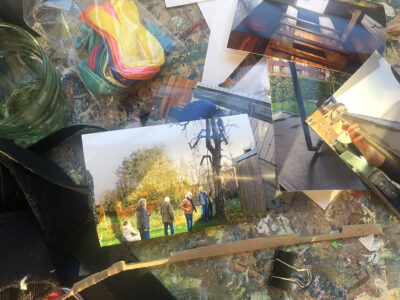27 September 2023
Interview
Every detail is important and matters, Elisia Poelman

Upon arrival in Zundert, Elisia Poelman is standing in the middle of the AiR van Gogh residency studio. She is still working on “the finishing touches”. Although there are several canvases that no longer need a brush, they are not yet finished. For Elisia, looking is also an important part of painting, or taking the time to see the possibilities of her own work. “Karel Appel said, ‘I’m watching it,’ and I’ve been thinking about that a lot over the past few days.”
Looking at your work, you are a painter in every sense of the word. What else is important to you when painting, apart from looking at your work?
Enthusiasm! I also enjoy working on several pieces at the same time. This gives them time to dry and allows me to take a step back. Sometimes there is almost too much going on in a piece. There is so much information that I sometimes make it difficult for myself, but that struggle is actually very exciting. That’s why I’ve also created three large works. For me, working on a large scale is a completely different experience than working on a small scale; there are so many more physical actions involved. I have to bend down, take a step back and then go back to look again. Here, I have the opportunity to work on a large scale. It’s also very emotional for me, the canvases that I brought here especially. The painting already has a story before it is painted. And that’s what I like about Vincent too; his works have travelled a lot and also experienced a lot.
What struck me is that you are wearing overalls that, with their pink colour and the paint on them, suit your work very well.
I bought it especially for here. I like it when people see that the work reflects someone, me as the creator. It radiates authenticity. Painting is also about making choices; it is an impression of what you see and feel. Every detail is important and matters. That is true when writing a text, when cooking, and it is also true when painting. Details can make or break it.

Photo by Rachel Gruijters
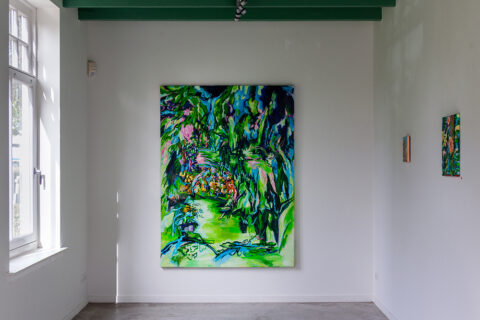
Photo by Rachel Gruijters
I want to go back to the beginning. You arrived here with your canvases and materials, and then what happened?
I had been looking forward to working here for a long time. This is my second residency; everyone knew how much I wanted to be here. I had all my materials ready, and when I arrived, I immediately set them out in the studio so I could get started right away. I was instantly happy. The period was an emotional rollercoaster for me because you spend a month alone with your work and your thoughts. That affects you. I think that also has to do with certain choices I’ve made in my life. That’s my connection with Vincent. I decided to quit my jobs [teaching, ed.] and focus entirely on my artistic practice. I was ready for that, but my environment wasn’t, and so I talked myself into being afraid. Now I’m 26, and in a few years I wouldn’t dare anymore. By then I might have a house, a family. Vincent was also 26 when he decided to become an artist, which is quite late; I had known for much longer. It is a comfort to me to know that Vincent also made that decision at that age. Even though his path was bumpy, I know exactly how that feels, so I can only imagine how much harder it must have been for him in much more difficult times.
When Vincent van Gogh made his decision to become an artist, he had the support of his younger brother Theo. Do you also have someone who supports you?
He’s my boyfriend, after all. He also wants me to be able to pursue my dream. I’ve not only quit my job, but also terminated my lease. Starting in November, we’ll be living a nomadic lifestyle. We’ve bought a van and are going to convert it so we can live in it. Then we’ll head south together this winter. I’ll be painting outdoors.

Photo by Esther van Rosmalen

Photo by Esther van Rosmalen
That’s an exciting step. What inspired you to make this choice?
The feeling that I also have to make choices because I need more time to work. I am a slow worker, and sometimes I repaint the canvas after a whole day if it doesn’t feel right to me. That’s clearer than continuing to work. I’m not afraid of that; destruction is actually letting go. I never regret anything. Sometimes it is necessary to remove things in order to see new things. And that also applies to choices in life; you cannot gain new experiences if you do not give anything up. Now, for the first time, I feel that I have the space in my life to work without other things getting in the way. That I also have to spend time on my work every day to stay sharp. That is why it makes me happy.
And does travelling itself play a role too?
I find it amazing how much Vincent travelled in his day. I know people my age who have never seen the sea. Travelling is necessary to discover new things, other people. People in the south are also different, more informal.
I have always travelled a lot, to South America, in Europe. My previous residency was in southern Spain and lasted two weeks. It was beautiful, but very off the grid. It was more about the experience than about creating work. I did have many conversations with the other artists; you shared a lot there. Here it is very different. Here I am alone, and that is also nice. I would like to do more residencies, I would like to work with clay, I want to learn more, and for that I have to travel.
And what have you learnt from being here? Has anything changed in your work or your working methods?
Something has definitely changed in my painting, and that is the thicker, more impasto application of paint. With Vincent, it feels as if he has just applied the paint to the canvas; that is due to his way of painting. That was my goal, to apply that more. That is certainly the case with my large canvases and my rose painting. And the material: I used to work with acrylic, but that is too plastic, so now I use it as an undercoat. Oil takes more time, and I have that now. Oil paint is so much more intense in colour. Now I can also use my hands physically; it feels like entering into a conversation, I can chat much more with a work. There is also always a moment with a work when I have to cry, because of how much time I have put into it. When that happens, I know I am doing well.
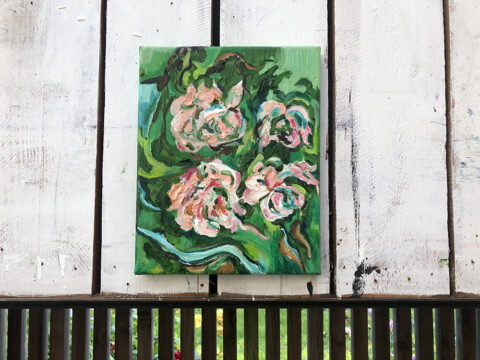
Photo by Esther van Rosmalen

Photo by Esther van Rosmalen
And what else did you do during your work period here in Zundert?
I have also made drawings on the iPad, which is enjoyable. The colours are very different from paint. And I can do it anywhere, even when I’m in the car. I can also see how the composition works as I go along. And I have made Polaroids, which I use to work from. The iPad, the Polaroids, the painting, it’s a constant interaction. I always start from observation, but all kinds of things come together in that. There is no one right way. My subjects are inspired by my immediate surroundings, such as trees, tree roots, pears from the pear tree and dahlias. I had to, because the first day I arrived here, there was a flower parade. And Vincent’s last painting features roots. From May to August this year, I took part in an exhibition in the Ardennes. There I saw a weeping willow, which I sketched and brought back with me. My roots from there, roots here, his last painting with roots, it all came together.
And are there any other influences that you have brought with you here?
I spent my childhood in Geraardsbergen and Ghent – where my studio is still located, as I haven’t given it up yet – and the landscape of my teenage years has certainly influenced me. I brought my sketchbook with me, which I have been working on here. A book is much more intimate. It’s very spontaneous; it’s just a book, it doesn’t have to be hung on the wall. It’s also small; if you work on a large scale, you have to do everything ten times over. When I’ve already sketched something, choices have already been made. Information is lost, or rather, it’s filtered. So, in essence, you can move on with it. A Polaroid makes the choice for you. And that’s quite picturesque, too.

Photo by Esther van Rosmalen
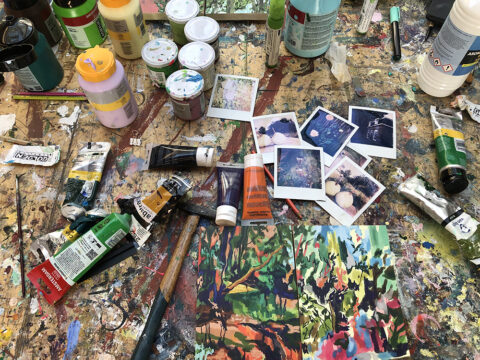
Photo by Esther van Rosmalen
If you had to choose from everything you have created here, what would make you happiest?
The work with the roses was painted very spontaneously, based on a detail from a painting by Vincent that I found in a book. You can learn a lot from studying the masters. Now I have created my first painting here, using oil paint. I see it as a tribute to Vincent.
And the sides of the canvases are also part of the painting. Why did you choose to do that?
The sides are very important in a work; I like the image to continue. I always look at the sides of other people’s paintings too. They say a lot about someone, whether that person works neatly. I am a bit messier myself, but that can be part of the work. Stopping at the edge seems so limited to me; canvases are three-dimensional. You should be able to view a painting from all sides. Even with iPad drawings, which I print on wood, I paint the edges in a colour; that’s part of it. And then I pour resin over it so that it shines just like the screen. I also continue working on the print; it’s not finished right away.
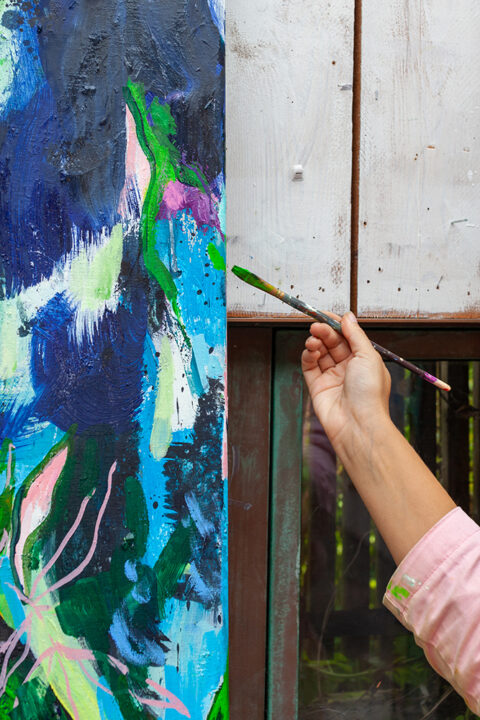
Photo by Rachel Gruijters
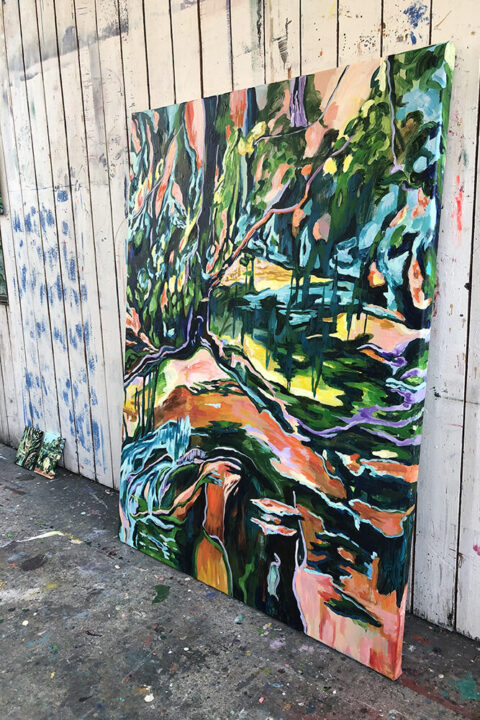
Photo by Esther van Rosmalen
How would you summarise this residency?
I feel very connected to Vincent. Here, I learned how difficult his life was. I knew that, of course, but being here, seeing the grave of his older brother Vincent, realising that he stood there too… That suffering explains his inner turmoil; perhaps that is where it comes from. At the same time – and this may not make me very popular – I don’t want to glorify him too much. You can’t relate everything to him. Other artists need to be given breathing space too. I think he would want that too, but I understand; people need the narrative.
Esther van Rosmalen, September 2023

